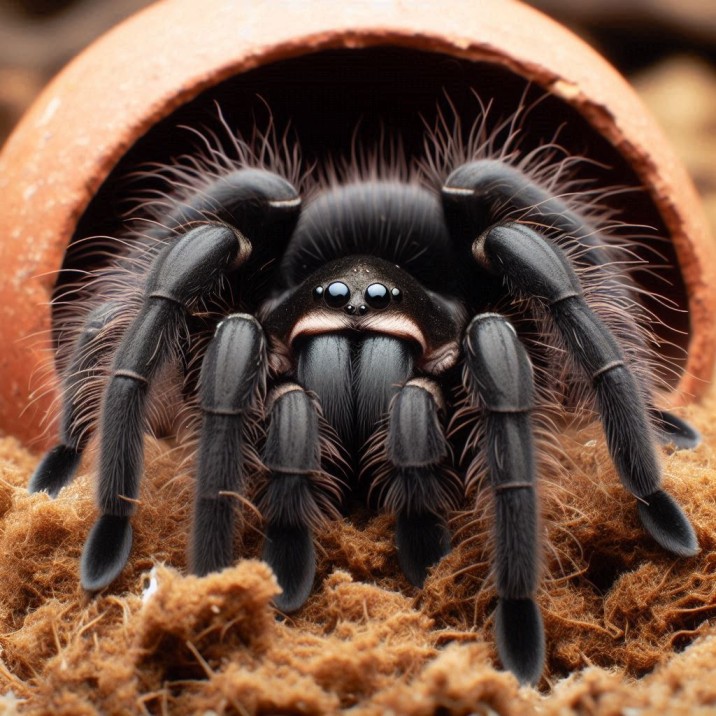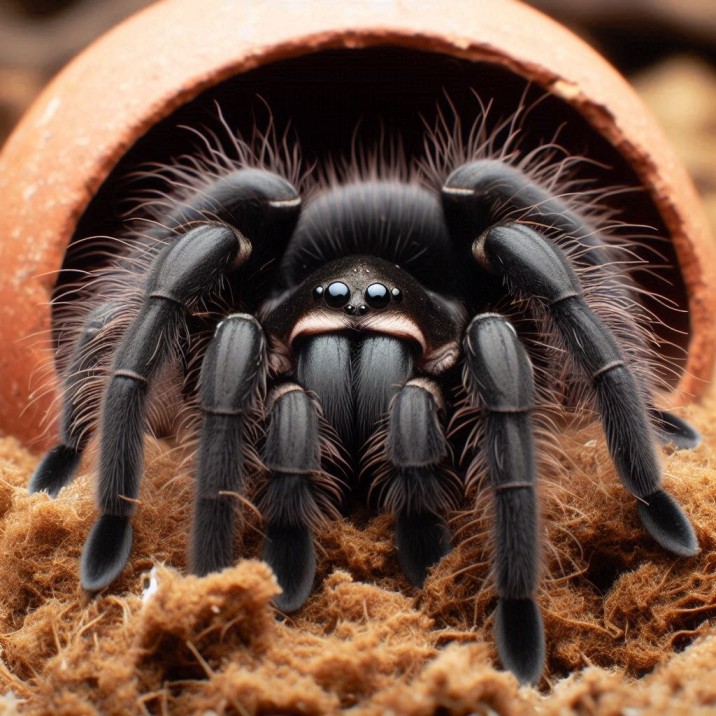Brazilian Black Tarantula
Table of Contents
Introduction
Have you ever wondered about the amazing world of tarantulas? These big, hairy spiders might look scary, but many are actually quite gentle. One of the most interesting types is the Brazilian black tarantula. Known for its shiny black color and calm nature, this spider is not only a favorite among pet enthusiasts but also a fascinating creature in the wild.
In this article, we’ll explore everything you need to know about the Brazilian black tarantula. From its appearance and behavior to its habitat and care, you’ll learn why this tarantula is so special. We’ll also answer some common questions about these spiders. So, let’s dive into the world of the Brazilian black tarantula!

Table of Contents
- Introduction
- What is a Brazilian Black Tarantula?
- Appearance of the Brazilian Black Tarantula
- Behavior and Temperament
- Natural Habitat and Distribution
- Diet and Feeding
- Care in Captivity
- Reproduction and Lifespan
- Interesting Facts
- FAQs
- Conclusion
What is a Brazilian Black Tarantula?
The Brazilian black tarantula, scientifically known as Grammostola pulchra, is a type of spider found mainly in Brazil and Uruguay. It’s famous for its smooth, black body and gentle nature. This tarantula is often kept as a pet because it’s easy to care for and not aggressive.
Why is it Called the Brazilian Black Tarantula?
The name comes from its home country, Brazil, and its striking black color. It belongs to the tarantula family, which includes many large and hairy spiders.
Appearance of the Brazilian Black Tarantula
One of the first things you’ll notice about the Brazilian black tarantula is its beautiful, shiny black color. Unlike some spiders that have different colors or patterns, this tarantula is all black.
Size and Features
- Leg Span: An adult female can grow up to 6-7 inches (15-18 cm) across, while males are slightly smaller.
- Body: Its body is covered with fine, velvety hairs that give it a smooth appearance. This makes it look quite elegant, even though it’s a spider!
Unique Black Color
The black color helps the tarantula blend into its surroundings, making it harder for predators to spot it. This color also makes it a popular pet because it looks striking in a terrarium.
Behavior and Temperament
The Brazilian black tarantula is known for being very calm and gentle. Unlike some other spiders, it’s not quick to bite or act aggressively.
Calm and Gentle Nature
- Docile: This tarantula is often described as docile, meaning it’s very gentle and not likely to bite.
- Handling: Because of its calm nature, it’s easier to handle than many other types of tarantulas.
Defensive Behavior
Even though it’s usually calm, the Brazilian black tarantula can defend itself if it feels threatened. It has special hairs on its abdomen that it can flick at predators to scare them away.
Natural Habitat and Distribution
The Brazilian black tarantula is found in the grasslands and forests of Brazil and Uruguay. It likes warm, humid places where it can find lots of insects to eat.
Where Does It Live?
- Brazil and Uruguay: These countries have the right climate and environment for the tarantula to thrive.
- Grasslands and Forests: It prefers areas with lots of cover, like tall grass or dense forests, where it can hide from predators.
Burrowing Habits
In the wild, the Brazilian black tarantula likes to dig burrows in the ground. These burrows help protect it from the hot sun and keep it safe from predators.
Diet and Feeding
The Brazilian black tarantula is a carnivore, which means it eats other animals. Its diet includes insects and small animals that it can catch and overpower with its strong legs and fangs.
What Does It Eat?
- Insects: Crickets, roaches, and other small bugs are its main food.
- Small Animals: Sometimes, it might catch a small mouse or another tiny animal if it gets the chance.
Hunting Techniques
The tarantula uses its powerful legs to grab its prey and its sharp fangs to inject venom. This venom helps to immobilize the prey, making it easier for the tarantula to eat it.
Care in Captivity
Keeping a Brazilian black tarantula as a pet is relatively easy because it doesn’t need a lot of special care. However, there are some things you need to know to keep your tarantula healthy and happy.
Enclosure Setup
- Size: The enclosure should be large enough for the tarantula to move around. A 10-15 gallon tank is usually enough.
- Substrate: Use a mix of coconut fiber and soil to create a deep layer for burrowing.
- Hiding Places: Include some rocks, pieces of wood, or other decorations where the tarantula can hide.
Temperature and Humidity
- Temperature: Keep the enclosure at 70-80°F (21-27°C).
- Humidity: Maintain a humidity level of 65-75%. You can do this by misting the enclosure with water.
Feeding Your Tarantula
- Diet: Feed your tarantula a variety of insects, like crickets or roaches, about once a week.
- Water: Provide a shallow dish of water for your tarantula to drink from.
Handling Tips
Even though the Brazilian black tarantula is calm, it’s best to handle it gently and not too often. Always wash your hands before and after handling to avoid stressing your tarantula or getting bitten.
Reproduction and Lifespan
The Brazilian black tarantula has a fascinating life cycle, from baby spider lings to adult tarantulas. Let’s take a look at how they reproduce and how long they live.
Mating and Egg Laying
- Courtship: Male tarantulas perform a special dance to attract females. If the female is interested, they will mate.
- Egg Cocoon: After mating, the female lays eggs and wraps them in a silk cocoon. She guards the cocoon until the baby tarantulas hatch.
Lifespan
- Females: Can live up to 20 years, making them long-lived pets.
- Males: Typically live for 5-7 years after reaching maturity, which is shorter than females.
Interesting Facts
Here are some cool facts about the Brazilian black tarantula that make it even more interesting!
- Non-Venomous to Humans: While it has venom, it’s not dangerous to humans and is used mainly to catch prey.
- Nocturnal: This means it’s most active at night, which is when it hunts for food.
- Low Maintenance: Compared to other exotic pets, it’s easy to care for, making it a great choice for beginners.
Conclusion
The Brazilian black tarantula is an amazing creature that is both beautiful and gentle. Its striking black color and calm nature make it a favorite among spider enthusiasts and a fascinating subject to learn about. Whether you’re interested in keeping one as a pet or just curious about these incredible spiders, the Brazilian black tarantula has a lot to offer.
FAQs
1. Are Brazilian black tarantulas dangerous?
No, they are not dangerous to humans. Their venom is used to catch prey and is not harmful to people.
2. How big do Brazilian black tarantulas get?
Females can reach up to 7 inches in leg span, while males are usually smaller.
3. Can I handle my Brazilian black tarantula?
Yes, you can handle them, but it’s best to do so gently and not too often to avoid stressing them.
4. What do Brazilian black tarantulas eat?
They mainly eat insects like crickets and roaches but can also eat small animals.
5. How long do Brazilian black tarantulas live?
Females can live up to 20 years, while males live for about 5-7 years after maturity.

